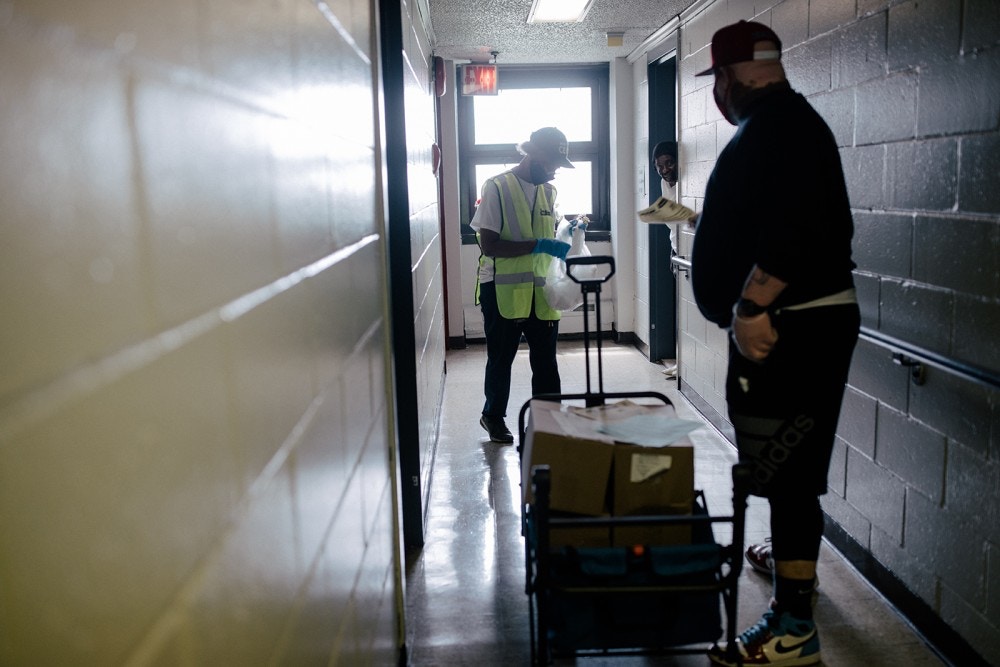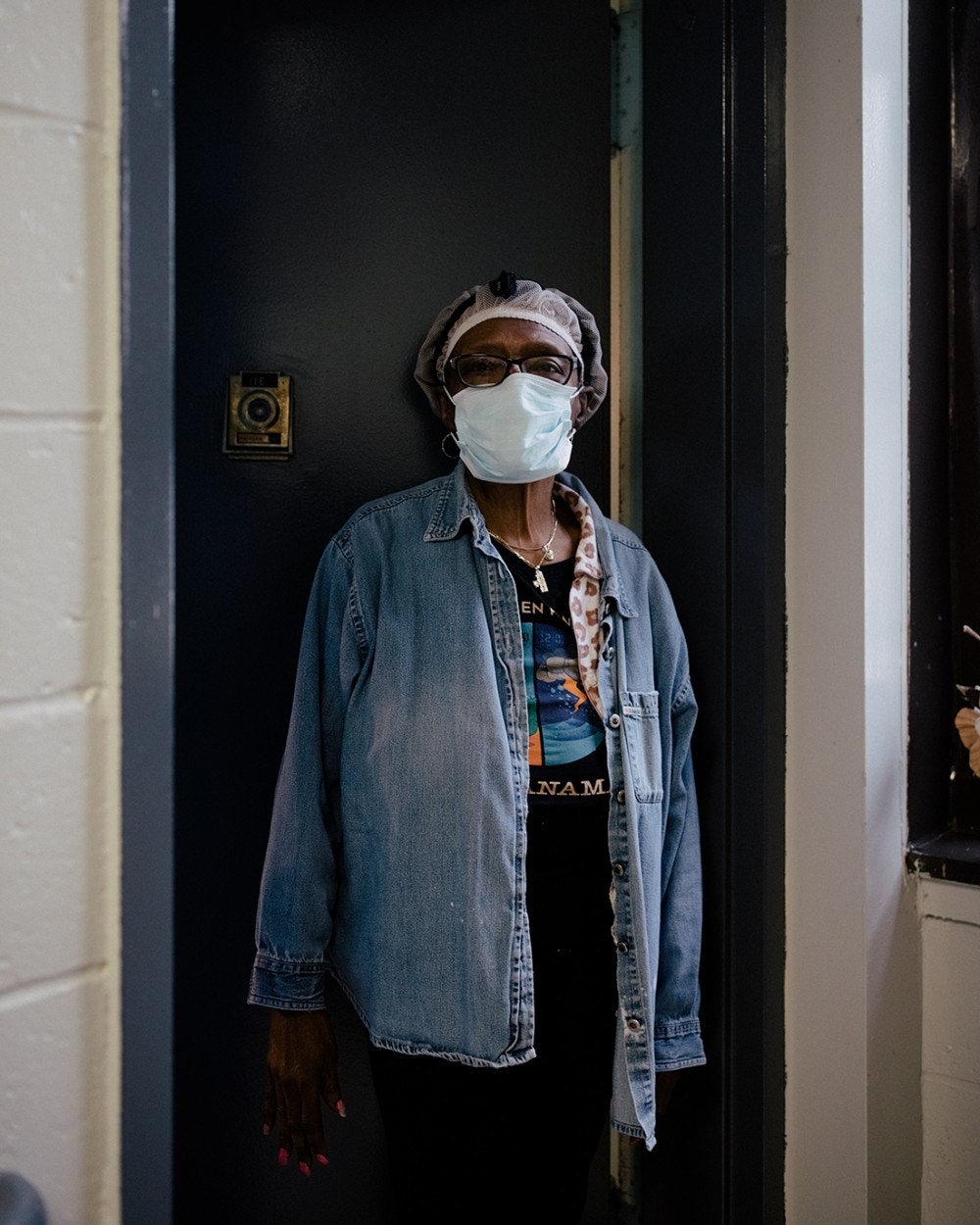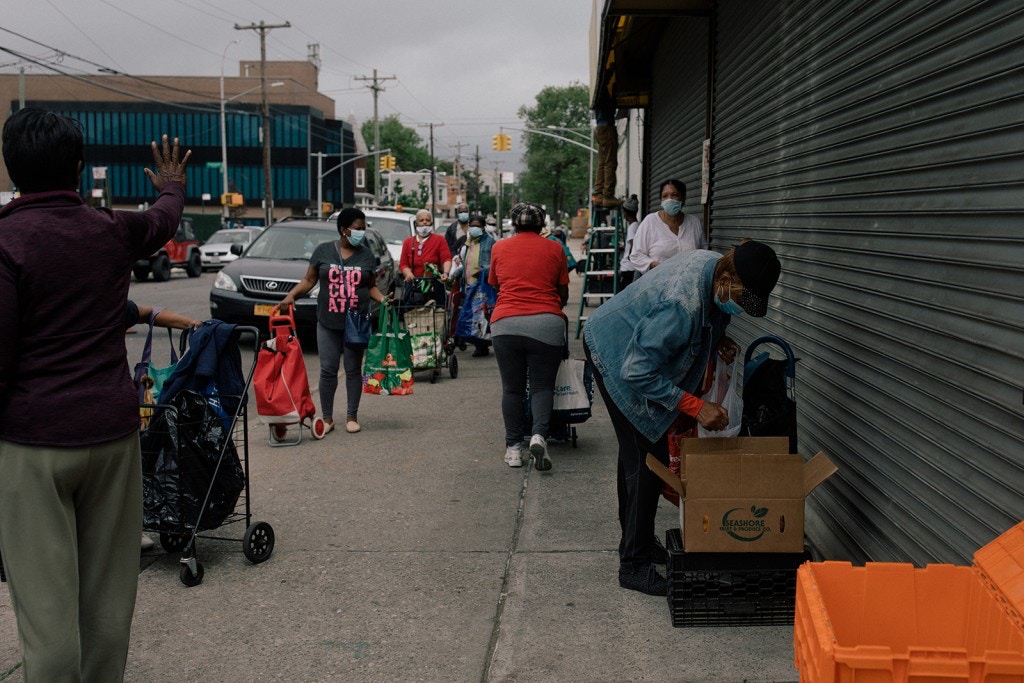Annie Louis got on the line just after 7 a.m. Three hours later, she was still waiting, inching her way down 95th Street in the Brooklyn humidity. She was tired. Her knees hurt. And Louis, who is 61 and suffers from diabetes and hypertension, worried that being out among people — some masked and some not — might increase her chances of being infected with the coronavirus. Still, she had no intention of getting off the queue that snaked around three blocks of modest homes in Canarsie. She was finally close enough to see the Children of the Light Food Pantry, where fresh fruits, vegetables, and, she hoped, some protein awaited.
“We need protein,” said Louis, gesturing toward her cousin, who was waiting alongside her and said that she, too, was hoping for groceries to put in her empty pantry. “Most of the days now, we don’t get protein. We’re living off vegetables and rice,” said Louis, who has worked as a home health aide for years. While the wages are low, in the past she’s usually earned enough to put food on the table. But since the pandemic began, she hasn’t worked and her savings dried up weeks ago. “I don’t have a dime, my bills are piling up, and rent is due right now,” she said.
“I don’t have a dime, my bills are piling up, and rent is due right now.”
Canarsie, where Louis lives, has the highest death rate from the coronavirus in New York City. And though several of her friends have gotten sick with Covid-19, and she still fears infection, Louis’s main focus has recently shifted to getting enough to eat. And she’s not alone. Across the city, in neighborhoods that have been most devastated by the virus — which also happen to be the neighborhoods where poverty is greatest — hunger is emerging as the primary concern. In Canarsie, where the median household income is $26,275, the need is overwhelming. “I’ve never seen anything like this in my life,” said Gardy Brazela, chair of the local community planning board, who ran out of food after distributing 700 boxes to people in front of the local police precinct on a recent Wednesday. “It’s bad, bad, bad, bad.”
The pandemic has caused historic levels of hunger nationwide. Drone footage of seemingly endless lines of cars waiting to pick up food from pantries in Pennsylvania, Florida, and Texas convey the scope of our new reality, in which food insecurity is meaningfully higher than at any point for which there is comparable data, as a study by the Brookings Institution found. According to that report, more than 1 in 5 households in the U.S. were food insecure by the end of April, the most recent month for which data is available, as were 2 in 5 households with mothers of children ages 12 and under.
In New York City, still the hardest hit part of the country, some 2 million residents — 1 in 4 — are food insecure, according to an estimate Mayor Bill de Blasio shared at a press briefing in late May. Already, by mid-April, after just a few weeks of quarantine, 38 percent of parents in New York City reported cutting the size of meals or skipping meals for their children because they did not have enough money for food in the previous month, according to a survey Hunger Free America released at the time. The survey also found that 34 percent of adults in New York City skipped meals or cut their portions because they didn’t have enough money for food.
Organizations have been expanding and forming anew to meet the enormous need. A colorful sign festooned with vegetables on the storefront that houses the Children of the Light Food Pantry says that it is only open for a few hours on certain days and specifies that it operates “by appointment.” But since late March, as the demand for food has swelled, the pantry has been open seven days a week and has fed between 500 and 700 people per day — well over twice the usual number. Children of the Light rented a port-a-potty for the people who line up as early as 5 a.m. And according to the pantry’s director, Pastor Maureen Rush, the volunteers regularly run out of the fresh food before the line is done.
“Each week, the crowd has gotten bigger.”
Deborah Hoyle, program director of the Ocean Bay Cornerstone Community Center, anticipated the hunger crisis as soon as lockdown began. The neighborhood has no grocery stores, and some residents were already struggling with hunger before the pandemic. “This community has been riddled by a lot of things,” said Hoyle, who began thinking about how the center could help with food distribution as soon as the pandemic hit. She arranged for food donations through Campaign Against Hunger and City Harvest, among other organizations, procured tables and tents that she set up in front of Ocean Bay Apartments housing complex on Beach Channel Drive, gathered a crew of volunteers, and made sure that there enough was personal protective equipment and hand-washing supplies for everyone. “I’m good at logistics,” she told me.
Still Hoyle wasn’t prepared for the intensity of the demand for food that became apparent as soon as they began giving out dry and canned goods and root vegetables on April 8. “When we opened, I turned around and said, OK, there are 10 people on line. OK. I can handle that. But then I looked up again and the line was down the block. And the next thing I knew, I heard it went all the way from 58th to 54th Street,” she said. And that was just the first week. Since then, the group has also begun giving out fresh vegetables, milk, and eggs. “And each week, the crowd has gotten bigger.”
Yet the surging crowds at food distribution sites around the city are only the visible part of the problem. Whether because they’re ill or just particularly at risk of getting sick, many of the people who need food can’t stand in line for hours to get it. Recently, Hoyle saw an elderly woman shaking as she waited for hours at her distribution site. “I told her, ‘Don’t come out here again,’” said Hoyle, who added the woman to the list of people to whom her volunteers deliver free food.
In the Vandalia Houses, two New York City Housing Authority buildings for seniors between Canarsie and East New York, a small group of volunteers and staff members for a local nonprofit get brief glimpses of the need as they deliver groceries and face masks to elderly residents. Millie Marelle, a 70-year-old Vandalia Houses resident, wore a face mask as she opened her apartment door a few inches to accept the donation of bread and vegetables. Marelle said she hadn’t worked since the pandemic began, and sometimes doesn’t have enough money to buy food. Down the hall, 85-year-old Annie Marcello said she has only ventured out of her apartment to deposit her Social Security check since the pandemic began. Marcello expressed her gratitude for both the food and the human contact before closing and double-locking her apartment door.
Invisible Hands, a volunteer-run organization that was formed to bring food to immunocompromised and elderly people during the pandemic, got a measure of the intensity of financial need soon after it formed. The original idea for the organization had been to simply transport food that people purchased themselves online, since grocery delivery services like Fresh Direct and Instacart were overwhelmed. But in mid-March, Invisible Hands introduced a subsidy program that paid for up to $30 of food for those who needed it.
“It became very, very, very overwhelming very quickly,” said Simone Policano, one of the group’s three founders. “We were getting hundreds of calls a day, from social workers, from shelters.” So, after just three weeks in which it gave out more than $31,000 of food, the group decided that it could no longer provide subsidies. “It was a Band-Aid for a bullet wound,” said Policano. “We had to make a painful and hard call to run ourselves into the ground or stop the program. We were just this baby organization. And our system was entirely overrun.” Invisible Hands now delivers food paid for by pantries and other organizations but doesn’t subsidize the purchases.
Even more established organizations are struggling to keep up with the need. Citymeals on Wheels, which typically delivers more than 2 million meals to frail and elderly New Yorkers each year, expects to deliver an additional 1 million meals by the end of this year. The demand “has been unbelievable,” said Rachel Sherrow, associate executive director of Citymeals on Wheels, who said the group recently had to rent a new warehouse to store the additional food and has had to devise new procedures so that volunteers can remain socially distant while keeping up with the increased demand.
Some longtime advocates say they have been warning for years about the hunger the pandemic has exacerbated.
Some longtime advocates say they have been warning for years about the hunger the pandemic has exacerbated. “I wish I could say I was shocked by this, but it’s all utterly predictable,” said Joel Berg, CEO of Hunger Free America. “Most people don’t understand how many people were already at the edge.”
Berg, who has worked on alleviating hunger for more than 30 years, is all too familiar with the underlying issues. Nationwide, a quarter of Americans have either no savings or negative savings. In New York City, more than a million people were already hungry before the pandemic struck. And many more were living only a few paychecks away from it. The sudden loss of jobs and the increase of food prices due to the pandemic and the shutdown meant that many people need help paying for food for the first time in their lives. But the recent changes also mean that the hunger crisis that already existed in New York City has become only graver. “A boatload of people just went from hungry to hungrier,” said Berg.
The city government, already a huge provider of food, has dramatically amped up its food distribution to respond to the crisis. In March, de Blasio named Kathryn Garcia the city’s Covid-19 food czar to manage the effort. And in April, he announced a $170 million emergency plan to combat hunger, which has involved opening more than 400 food hubs where any New Yorker can get food. Taxi and Uber drivers help deliver the food. The city has expanded its Office of Food and Nutrition Services, which serves 850,000 meals a day to New York City public school students, making it second only to the U.S. military as the nation’s biggest food procurer. Now that office is feeding both students and their parents.
“People need to appreciate that they’ve done in a few weeks what government normally would take a few years to do,” said Berg. “They’re delivering over 1 million meals a day to people’s homes. Some are halal and kosher.” Berg described himself as “livid with the mayor over the policing issues,” but nevertheless acknowledged that the scaling up of food distribution that de Blasio has overseen has been “an enormous frigging undertaking.”
Still, even the most admirable responses from government and nonprofits throughout the city isn’t enough to meet the current need. “The demand is endless,” said Liz Accles, executive director of Community Food Advocates. Accles said that Pandemic EBT, which will bring the families of every New York City public school student $420 for groceries, should help. But it is a one-time payment. And she worries about what will happen after that money runs out, as state and federal budgets tighten.
“The austerity budgets are of a concern on so many levels,” said Accles. “We don’t know if there will be significant relief for food programs. The fear is that all the people who were struggling day to day before will be struggling even more and harder, and there will be a whole new group of people on top of them who need food.”
Already some programs aimed at alleviating hunger are going backward. The Nutrition Outreach and Education Program, which contracts with organizations that help people apply for federal benefits through the Supplemental Nutrition Assistance Program, or SNAP, recently notified its grantees that it had not received an expected renewal of its five-year contract with New York state, which is set to expire on June 20. Without a contract, 45 organizations throughout the state may have to lay people off or shut down entirely just when their services are needed most.
Some are hoping that the pandemic will spark a greater understanding of the causes of hunger, even while it’s causing vast suffering. Jahi Chappell, executive director of the advocacy organization Food First, said the roots of our current crisis lie in both the “barely-there social safety net” and the larger food system in which big agriculture and retail companies have too much power and farmers aren’t paid a living wage. “It all connects,” said Chappell, who described hunger as a structural injustice that, like police violence, need to be addressed systemically.
Until it is addressed, hunger, like police violence, is also one of the few things that can get people to emerge from their homes during a deadly pandemic. On a recent Wednesday, a small crowd gathered around a table piled with potatoes and apples on a dead end in Far Rockaway. The beach, which was just down the street, was empty. But on the block, music was playing as volunteers unloaded and stacked produce from boxes. Several passed around a cellphone on which they were FaceTiming with Cynthia Bryant, the founder of a local church who organizes the food distribution at the site remotely because she is undergoing chemotherapy.
Others at the pop-up food relief station were also responding to the food crisis with a generosity that seemed to defy the dark times. Desiree Hicks, a mother of four who lost her job in medical billing, was helping give out food because, she said, “I know what it is to be hungry.” Sharmaine Anderson, who drove an Uber before the shutdown and has little savings, had just spent much of her stimulus check on food that she distributed to neighbors. And Ron Halyard, a pastor, was preparing to fill the back of his black pickup truck with groceries. “We just keep loading it up and going through the neighborhoods,” said Halyard. “Every time we find someone who needs food.”
Sharon Lerner | Radio Free (2020-06-16T20:53:45+00:00) “We Need Protein” — Coronavirus Pandemic Deepens New York’s Hunger Crisis. Retrieved from https://www.radiofree.org/2020/06/16/we-need-protein-coronavirus-pandemic-deepens-new-yorks-hunger-crisis/
Please log in to upload a file.
There are no updates yet.
Click the Upload button above to add an update.



